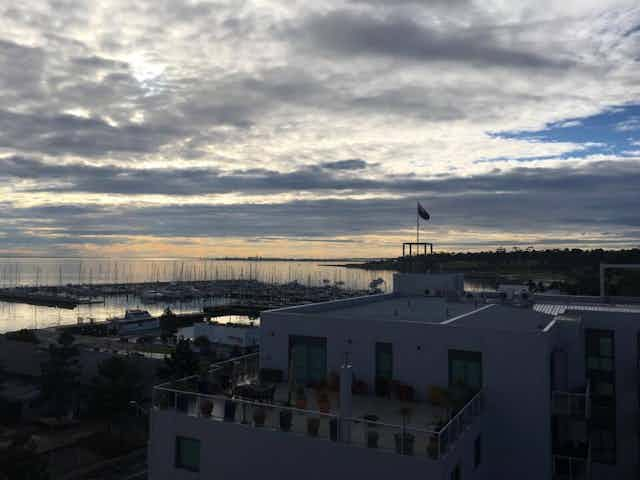“Our Future”, a year-long consultation process about a long-term vision for the City of Geelong, has begun. City of Greater Geelong CEO Kelvin Spiller engaged the first UNESCO chair of futures studies, Sohail Inayatullah, to kick-start the project in September.
Spiller, who has produced outcomes for city visioning initiatives on the Sunshine Coast, describes Our Future as a process of “presenting new perceptions, future directions, identifying used futures and new scenarios”. In a rapidly changing world, citizens use scenario thinking to gain insights into how cities can create alternative possibilities and solutions.
How does industry see the future?
Inayatullah helped workshops of industry professionals develop various industry scenarios:
-
Geelong’s emerging futures emphasise its great coastal beauty and its people’s strengths. The city remains small compared to the Gold Coast although, with 229,000 people, Greater Geelong is still among the largest of 561 local government areas in Australia. It is attractive, scenic and touristy. The city’s tranquil bay and marina, picturesque vineyards and proximity attract holidaymakers from Melbourne.
Artificial intelligence (AI) futures open up a journey on the digital highway to build crowdsourced ideas, new funding models and business start-ups. Geelong’s traditional motor vehicle manufacturing culture combines with a spirit of innovation and global enterprise. The city promotes, evolves and services the introduction of driverless cars, the gaming industry, smart technologies and robotics.
Geelong’s population density, growing diversity, economic mix and proximity to Melbourne’s demographic richness support it as a social and education city. Geelong increases its transport and connectedness to its unique destinations to attract wide interests, new worker profiles and residents seeking a “sea change” from Melbourne’s inner suburbs. Residents network with local business owners and workers to generate services and programs for regional neighbours and Melbourne’s markets.
What does the community want?
Guided by Inayatullah, a community interactive session used metaphors to bring home a message of continual transition. He describes the use of metaphors as being a decisive factor in shifting narrative strategy:
If you don’t innovate and create agency to shift your own narrative, then culture eats strategy for breakfast.
Geelong’s history of innovation includes the development of the world’s first ute and the first industrial refrigerator. This history suggests Geelong could provide services to global niche markets.
The community also suggested transitions from costly and unnatural botanic gardens to green bionic gardens – sprawling rooftop gardens, indoor gardens and rainwater systems flowing into indigenous gardens. Gardens would beautify municipal roads and infrastructure.
Another suggested transition was from being a “dormitory of Melbourne” to being a retreat for Melbourne holidaymakers and a “hive” location for its best thinkers to create their futures.
In the community session, I outlined Gold Coast’s Bold Future initiative. My presentation featured the city’s growth, including 100 new high-rises on the Surfers Paradise skyline in five decades.
Navigating different growth scenarios
The challenge for Geelong is to navigate through growth scenarios such as:
Sustainable growth: five new high-rises emerge to support low-level tourism, conference accommodation and a burgeoning education and health precinct.
Overdevelopment: an oversupply of residential and holiday maker apartments become difficult to fill, halting investment. Population waves are required to sustain rates and market base.
Underdevelopment: Gold Coast’s rapid growth raises questions about Geelong’s slow growth and missed opportunities to develop high-rises alongside celebratory events packages. These packages rely on transport and tourism infrastructure and include the building of stadiums. The strength of underdevelopment, however, is that Geelong remains a clean, green and historically beautiful seaside city.
Negative growth: collapse results in generations of hardship.
An outcome of Gold Coast’s 2037 vision is its Health and Knowledge Precinct. The 200-hectare site has generated more than A$5 billion in investment and is now linked by light rail to the city’s tourism centres.
Spiller noted that Geelong’s Our Future is continuing a 175-year process of reinvention. He hailed transformational metaphors that saw the city as more than a technology hub, potentially providing a deep commitment to networking to create a Silicon Valley. These have led to visions of transforming from a “resort city” to a “city of health and wellness”, from an “industrial, agricultural city” to a creative lifestyle, and from a “sleepy hollow” to an “emerging and sustainable city”.
Time for feedback on Geelong’s future
Our Future extends over five stages, with the final three to begin in 2017.
From January to March, the community can comment on ideas presented to date. Stages four and five will provide vision documents and conclude with an exhibition of the foresight journey the city has created.
Spiller and his team are developing a ten-to-30-year Our Future vision and strategies, for the city’s social, environmental and community infrastructure in particular. You can have your say about Geelong’s future via the Our Future survey.

